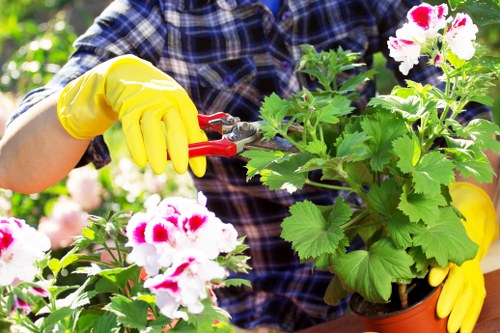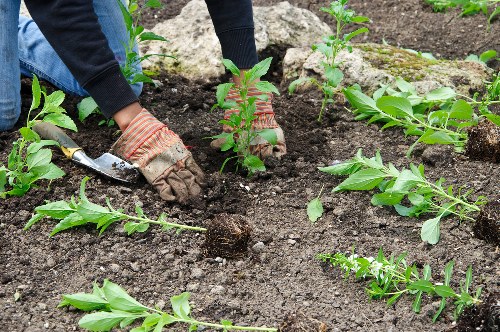Expert Hedge Trimming Services in East Ham
Introduction to Hedge Trimming

Maintaining a beautiful garden requires regular attention, and hedge trimming is a crucial aspect of garden upkeep. In East Ham, residents take pride in their well-maintained green spaces, and professional hedge trimming services play a vital role in achieving this.
Hedges not only enhance the aesthetic appeal of a property but also provide privacy, act as windbreaks, and serve as natural barriers. Whether you have a formal hedge lining your driveway or a more informal shrubbery in your backyard, proper trimming ensures that your hedges remain healthy and visually appealing.
In this article, we'll explore the benefits of hedge trimming, the best practices for maintaining your hedges, and why hiring a professional in East Ham is the best decision for your garden.
Benefits of Regular Hedge Trimming

Regular hedge trimming offers numerous benefits that go beyond just the aesthetics of your garden. Here are some key advantages:
- Promotes Healthy Growth: Trimming encourages new growth, making your hedges fuller and denser.
- Enhances Appearance: Well-trimmed hedges significantly boost the curb appeal of your property.
- Prevents Disease: Removing dead or diseased branches helps prevent the spread of infections.
- Encourages Shape: Regular trimming allows you to maintain the desired shape and size of your hedges.
- Increases Privacy: Thicker, well-maintained hedges provide better privacy from neighbors and passersby.
These benefits highlight why hedge trimming is not just a seasonal chore but a necessary ongoing maintenance task for any garden.
When to Trim Your Hedges

Timing is essential when it comes to hedge trimming. The best time to trim varies depending on the type of hedge and the local climate in East Ham.
Generally, the optimal times for trimming are:
- Late Spring: After the initial growth surge, trimming can help shape the hedge before the summer heat.
- Late Summer to Early Autumn: A second trim can tidy up the hedge and promote healthy growth for the next season.
- Avoid Trimming in Winter: Trimming during the dormant season can expose hedges to harsh weather conditions and potential damage.
By adhering to these guidelines, you ensure that your hedges remain strong and vigorous throughout the year.
Choosing the Right Tools for Hedge Trimming

Having the right tools is critical for effective hedge trimming. Professionals in East Ham use a variety of equipment to ensure precision and safety:
- Electric Hedge Trimmers: Ideal for small to medium-sized hedges, offering ease of use and efficiency.
- Gas-Powered Trimmers: Suitable for larger hedges that require more power and longer running times.
- Manual Shears: Perfect for detailed work and shaping, providing greater control over the trimming process.
- Loppers and Pruners: Essential for cutting thicker branches and maintaining the overall health of the hedge.
Using the appropriate tools not only improves the quality of the trim but also ensures the longevity of your hedges.
Professional Hedge Trimming Services in East Ham

While DIY hedge trimming is an option, hiring a professional hedge trimming service in East Ham offers numerous advantages:
- Expertise: Professionals have the knowledge and experience to handle different types of hedges effectively.
- Time-Saving: Trimming hedges can be time-consuming. Professional services allow you to focus on other important tasks.
- Safety: Trimming large hedges or those in difficult locations can be hazardous. Experts have the necessary equipment and skills to perform the job safely.
- Consistent Results: Professionals ensure that hedges are trimmed uniformly, enhancing the overall appearance of your garden.
Investing in a professional service guarantees that your hedges receive the best care possible.
Steps Involved in Professional Hedge Trimming
Assessment and Planning
The first step in professional hedge trimming is assessing the current state of your hedges. This includes checking for any signs of disease, pest infestation, or damage. Based on this assessment, a detailed trimming plan is formulated to ensure optimal results.
Preparation of Tools and Equipment
Professionals prepare their tools and equipment, ensuring everything is in good working condition. This includes sharpening blades, checking machinery, and setting up any necessary safety gear.
Trimming Process
The actual trimming involves cutting back the branches to the desired shape and size. Professionals pay close attention to the natural growth pattern of the hedge to maintain its health and appearance.
Clean-Up
After trimming, the area is thoroughly cleaned to remove any debris. This not only keeps your garden tidy but also prevents the spread of diseases and pests.
Final Inspection
A final inspection ensures that the trimming meets the desired standards and that there are no overlooked areas.
Maintaining Trimmed Hedges
After your hedges have been professionally trimmed, proper maintenance is essential to preserve their health and appearance. Here are some tips:
- Regular Watering: Ensure that hedges receive adequate water, especially during dry periods.
- Fertilization: Apply appropriate fertilizers to promote healthy growth.
- Pest Control: Monitor for pests and treat infestations promptly.
- Annual Trimming: Schedule regular trimming sessions to maintain the desired shape and prevent overgrowth.
Consistent maintenance extends the life of your hedges and keeps them looking their best.
Common Types of Hedges in East Ham

Boxwood Hedges
Boxwood is a popular choice for formal gardens due to its dense, evergreen foliage. It responds well to trimming, making it ideal for shaping into neat, geometric forms.
Privet Hedges
Privet is another common hedge plant known for its rapid growth and dense foliage. It's versatile and can be easily shaped to suit various garden styles.
Laurel Hedges
Laurel hedges are favored for their large, glossy leaves and thick growth. They provide excellent privacy and can withstand heavy trimming.
Yew Hedges
Yew is a classic hedge plant that offers both beauty and longevity. Its ability to thrive in various conditions makes it a reliable choice for East Ham gardens.
Environmental Benefits of Hedge Trimming
Beyond aesthetics, hedge trimming contributes positively to the environment:
- Promotes Biodiversity: Well-maintained hedges provide habitats for various wildlife, including birds and beneficial insects.
- Improves Air Quality: Healthy hedges act as natural air filters, absorbing pollutants and releasing oxygen.
- Reduces Soil Erosion: Dense hedges stabilize the soil, preventing erosion and maintaining garden integrity.
- Enhances Microclimates: Hedges can create favorable microclimates by providing windbreaks and shading.
These environmental benefits underscore the importance of regular hedge trimming as part of sustainable garden practices.
Cost Factors for Hedge Trimming in East Ham

The cost of hedge trimming services in East Ham can vary based on several factors:
- Size of the Hedge: Larger hedges require more time and resources to trim effectively.
- Type of Hedge: Some hedge species may require specialized techniques or tools, affecting the overall cost.
- Accessibility: Hedges located in hard-to-reach areas may incur additional charges.
- Frequency of Trimming: Regular maintenance contracts may offer discounts compared to one-time services.
- Additional Services: Services like pest control, fertilization, or disposal of debris can influence the total price.
It's advisable to obtain quotes from multiple providers to ensure competitive pricing and value for money.
DIY Hedge Trimming vs. Professional Services
While some homeowners may consider trimming their hedges themselves, there are significant advantages to opting for professional services:
- Expertise and Experience: Professionals can handle different hedge types with precision and care.
- Quality Tools: Access to high-quality tools ensures a clean and efficient trim.
- Time Efficiency: Professionals can complete the task faster, saving you time and effort.
- Safety: Trimming large or tall hedges can be dangerous without proper equipment and training.
- Consistency: Professionals ensure that the hedge retains a uniform shape and appearance.
Ultimately, hiring professionals often results in better outcomes and peace of mind.
Choosing the Right Hedge Trimming Service in East Ham

Selecting a reliable and skilled hedge trimming service is crucial for achieving the best results. Consider the following when making your choice:
- Reputation: Look for services with positive reviews and testimonials from satisfied customers.
- Experience: An experienced provider is more likely to handle various hedge types effectively.
- Insurance: Ensure the service is insured to protect against any potential damage or accidents.
- Pricing: Transparent and competitive pricing without hidden fees is essential.
- Customer Service: Choose a provider that values communication and customer satisfaction.
Taking these factors into account will help you find a trustworthy service that meets your garden's needs.
Preparing for Your Hedge Trimming Service
Clear the Area
Before the professionals arrive, ensure that the area around the hedges is clear of any obstacles. This includes removing furniture, toys, or other items that might hinder access.
Secure Pets and Children
For safety reasons, keep pets and children away from the trimming area during the service.
Discuss Your Preferences
Communicate your desired outcomes with the service provider. Whether you prefer a formal shape or a more natural look, clear instructions will help achieve the best results.
Aftercare Tips for Trimmed Hedges
Proper aftercare ensures that your hedges continue to thrive following a trimming session:
- Regular Monitoring: Keep an eye on your hedges for any signs of stress or disease.
- Appropriate Watering: Maintain consistent watering schedules, especially during dry spells.
- Mulching: Apply mulch around the base to retain moisture and regulate soil temperature.
- Fertilization: Provide necessary nutrients to support healthy growth.
- Pest Management: Address any pest issues promptly to prevent damage.
Implementing these aftercare practices will prolong the health and beauty of your hedges.
Seasonal Considerations for Hedge Trimming
Different seasons require specific approaches to hedge trimming to ensure optimal growth and health:
- Spring: Focus on shaping and removing any winter damage to prepare for the growing season.
- Summer: Light trimming to maintain shape and remove any overgrown branches.
- Autumn: Final trims before winter can help the hedges withstand colder temperatures.
- Winter: Generally, avoid trimming unless absolutely necessary, to prevent stress on the plants.
Understanding seasonal needs helps maintain the vigor and structure of your hedges throughout the year.
Innovative Techniques in Hedge Trimming
Advancements in gardening have introduced new techniques that professionals use to enhance hedge trimming:
- Topiary: Shaping hedges into intricate designs and figures adds a unique artistic touch to gardens.
- Layered Trimming: Creating layers within hedges can add depth and visual interest.
- Air Pruning: A method that encourages dense growth by allowing air to reach the roots.
- Smart Trimming Tools: Incorporating technology for precision trimming and efficiency.
These innovative methods contribute to more creative and sustainable hedge maintenance.
Environmental Sustainability in Hedge Trimming
Emphasizing sustainability ensures that hedge trimming practices are environmentally friendly:
- Using Eco-Friendly Tools: Opt for electric or battery-powered trimmers to reduce carbon emissions.
- Recycling Green Waste: Composting trimmed branches and foliage minimizes waste.
- Organic Fertilizers: Utilize natural fertilizers to promote healthy growth without harming the environment.
- Conserving Water: Implement efficient watering systems to reduce water usage.
Adopting sustainable practices benefits both your garden and the planet.
Common Mistakes to Avoid in Hedge Trimming
Avoiding common mistakes ensures that your hedges remain healthy and attractive:
- Over-Trimming: Cutting too much can stress the plant and hinder growth.
- Incorrect Timing: Trimming at the wrong time of year can damage the hedge.
- Poor Tool Maintenance: Dull or rusty tools can cause uneven cuts and spread diseases.
- Ignoring Hedge Health: Failing to address underlying health issues can lead to further problems.
- Improper Shaping: Maintaining a natural shape is crucial to avoid an unnatural appearance.
Being mindful of these pitfalls contributes to effective and sustainable hedge trimming.
Hedge Trimming FAQs
How often should I trim my hedges in East Ham?
Typically, hedges should be trimmed 2-3 times a year, depending on the growth rate and type of hedge.
Can I trim my hedges myself?
While DIY trimming is possible, hiring professionals ensures a precise and safe trim, especially for larger or more complex hedges.
What tools are essential for hedge trimming?
Essential tools include hedge trimmers (electric or gas-powered), loppers, pruners, and safety gear.
Does hedge trimming affect the health of the plant?
Proper trimming promotes healthy growth, while over-trimming or incorrect techniques can harm the plant.
What are the best hedge plants for East Ham gardens?
Popular choices include boxwood, privet, laurel, and yew, all of which thrive in the local climate and respond well to trimming.
Conclusion
Investing in professional hedge trimming services in East Ham not only enhances the beauty and functionality of your garden but also ensures the long-term health of your hedges. By understanding the benefits, best practices, and the value of expert care, you can maintain a stunning and sustainable garden that stands out in the community.
Don't wait to transform your garden into a lush, well-maintained oasis. Contact us today to schedule your hedge trimming service and experience the difference that professional expertise can make.